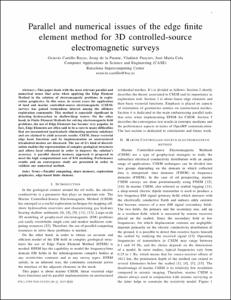Parallel and numerical issues of the edge finite element method for 3D controlled-source electromagnetic surveys

Visualitza/Obre
10.1109/ICCSAT.2015.7362921
Inclou dades d'ús des de 2022
Cita com:
hdl:2117/85912
Tipus de documentText en actes de congrés
Data publicació2015-10
EditorIEEE
Condicions d'accésAccés obert
Tots els drets reservats. Aquesta obra està protegida pels drets de propietat intel·lectual i
industrial corresponents. Sense perjudici de les exempcions legals existents, queda prohibida la seva
reproducció, distribució, comunicació pública o transformació sense l'autorització del titular dels drets
Abstract
This paper deals with the most relevant parallel and numerical issues that arise when applying the Edge Element Method in the solution of electromagnetic problems in exploration geophysics. In this sense, in recent years the application of land and marine controlled-source electromagnetic (CSEM) surveys has gained tremendous interest among the offshore exploration community. This method is especially significant in detecting hydrocarbon in shallow/deep waters. On the other hand, in Finite Element Methods for solving electromagnetic field problems, the use of Edge Elements has become very popular. In fact, Edge Elements are often said to be a cure to many difficulties that are encountered (particularly eliminating spurious solutions) and are claimed to yield accurate results. CSEM, linear vectorial edge basis functions and its implementation on unstructured tetrahedral meshes are discussed. The use of it’s kind of discretisation enables the representation of complex geological structures and allows local refinement in order to improve the solution’s accuracy. A parallel shared memory approach is proposed to meet the high computational cost of EM modeling. Performance results and an convergence study are presented in order to validate our numerical method.
CitacióCastillo-Reyes, Octavio [et al.]. Parallel and numerical issues of the edge finite element method for 3D controlled-source electromagnetic surveys. A: International Conference on Computing Systems and Telematics (ICCSAT), Xalapa, 28-30 Oct. 2015. "2015 International Conference on Computing Systems and Telematics (ICCSAT): 28-30 Oct. 2015". Xalapa: IEEE, 2015, p. 1-6.
ISBN978-1-4799-7637-9
Versió de l'editorhttps://ieeexplore.ieee.org/document/7362921/
| Fitxers | Descripció | Mida | Format | Visualitza |
|---|---|---|---|---|
| Parallel and nu ... ues of the edge finite.pdf | 1,153Mb | Visualitza/Obre |

